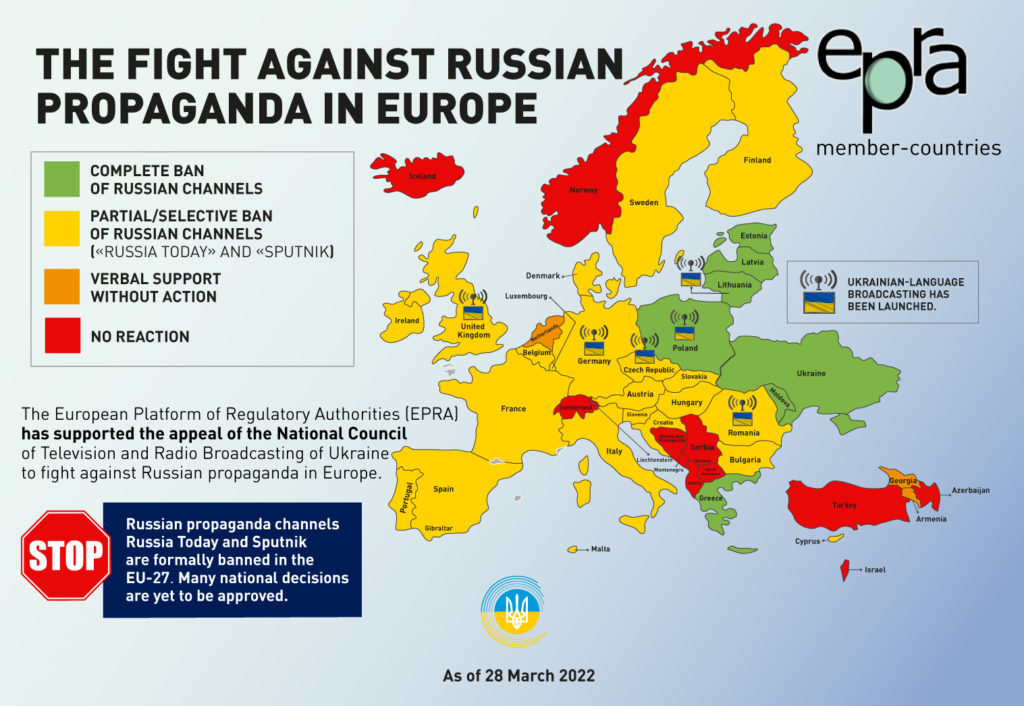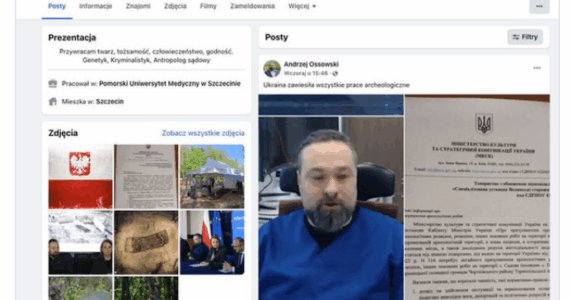Navigation and useful materials
Partial or regional RT blocking is ineffective as the Kremlin state media finds new ways to promote their propaganda messages into the world’s information space. Therefore, in order to counteract RT effectively, a complete and coordinated ban on all possible channels of broadcasting is necessary. The Centre for Strategic Communication and Information Security analyzed the situation with blocking RT in the world.
RT: history, people, and true role
RT is a state-run Russian media outlet that has existed since 2005, has been funded by the Russian government, and has been promoting the Kremlin’s propaganda narratives for many years.
The pool of people involved in the creation, management of RT, and dissemination of disinformation rhetoric includes the most famous Russian propagandists — Dmitry Kiselyov, Margarita Simonyan, who for years stirred up hostility to Ukraine on Russian TV channels, Anton Krasovsky, who calls for “drowning in the river or burning Ukrainian children,” threats to “burn Ukrainians on Khreshchatyk together with the Ukrainian Constitution” and “joy” due to the massive Russian missile attacks on Ukraine.
The real role of RT is to be the Kremlin’s mouthpiece for Russian and foreign audiences because the media is broadcast in Russian, English, Arabic, Spanish, French, German, and even Serbian.
In addition, the channel’s management does not object to this role at all. Thus, in an interview with a Russian publication, the main propagandist and editor of RT Margarita Simonyan calls the channel a “part of soft power” and compares it with the “Ministry of Defence,” which “has no relation to journalistic objectivity.”
However, RT poses an information threat not only to Ukraine, but also to the world. Kremlin propaganda used RT to spread fakes, manipulations, defamatory and propaganda campaigns long before Russia’s full-scale invasion of Ukraine. Messages disseminated by this resource discredited not only the Ukrainian state, but the entire democratic world, fuelled hostility towards Western countries, international organizations, and undermined confidence in the health care system.
Read more about RT’s most high-profile disinformation cases in the first part of the study of the Centre for Strategic Communication and Information Security “RT: Why Russian State Media Has No Place in Civilized World” based on the analysis of the content of Russian and foreign offices of the Kremlin’s propaganda resource.
RT channels for spreading Kremlin propaganda
In fact, RT’s network of channels is still massive to influence, regardless of the blocking of TV channels and banning of pages by some social networks. For example, throughout its existence, RT used the following channels (some of them are currently inactive in certain regions):
Websites. The RT site, as the main platform for increasing accessibility and audience reach for propaganda impact, has seven languages of broadcasting — English, Arabic, German, French, Spanish, Serbian, and Russian. Online platforms also include RUPTLY multimedia agency (in English, Russian, Spanish, and Arabic).
TV channels. The network of RT also includes RT Russia, RT America, RT France, RT UK, RT DE, RT en Español, RT Arabic, RT Documentary. Since November 15, 2022, RT has announced the launch of a new propaganda multimedia online portal RT Balkan in Serbian, television broadcasting is scheduled, according to RT, by 2024.
Social media. RT also has a list of social media sites where you can also track the content of propaganda media. For the most part, these are Russian platforms. For example, Vkontakte, Odnoklassniki, RuTube, LiveJournal (since December 2016, hosted by the Russian company Rambler&Co), ZenYandex, and Telegram. Twitter, Viber are currently on offer among foreign ones. Until 2022, RT had its own pages on Facebook, Instagram, TikTok, and YouTube (however, there is a continuing spread of RT content through these social networks, including through the creation of new pages, groups, and channels).
There may be even more such channels, given the way RT tries to dodge any bans and blocking.
Blocking TV channels
Ukraine was one of the first to realize the perniciousness of Russian propaganda, and back in 2014, banned the broadcasting of 14 Russian TV channels, including RT.
In 2020, Russian RT TV channels were also banned from broadcasting in Lithuania and Latvia. The reason for the blocking was the connection of the media with Kiselyov, who is under EU sanctions.
In March 2022, the EU imposed sanctions on RT English, RT UK, RT Germany, RT France, RT Spanish and stopped broadcasting them in EU countries.
However, it is difficult to determine the exact total number of countries in the world that have blocked RT to date due to the lack of such statistics. However, according to the European Platform of Regulatory Authorities (posted on the website of the National Council of Television and Radio Broadcasting), as of March 28 in Europe, RT has been blocked in 30 countries.

Technical companies and telecommunications providers in Australia, Canada, and the United States (and in particular, RT America channel) also reported the blocking of Russian state-owned media due to Russia’s full-scale invasion of Ukraine.
Blocking by social networks and technology companies
At the beginning of Russia’s full-scale invasion of Ukraine, a number of social networks and technology companies announced the blocking and refusal to cooperate with RT. For example:
Meta (Facebook, Instagram). The platform announced restrictions on access to RT pages, in particular for EU countries. It is also worth noting that Russia itself took measures in response to these social networks and announced a ban on Facebook and Instagram in Russia.
YouTube. Following Russia’s full-scale invasion of Ukraine, Google, which owns YouTube’s video hosting, has blocked numerous RT resources, including in the EU and Ukraine. YouTube has also recently blocked another newly created channel of the Russian RT TV network, the Balkan unit of RT Balkan broadcaster.
According to Twitter and Google, these platforms have also begun limiting the visibility of RT content worldwide.
Spotify has reported the removal of all RT content from its service.
TikTok. At the beginning of the full-scale invasion, TikTok also announced the blocking of RT pages and their content in EU countries.
Microsoft was the first major tech company to cut ties with the network by removing RT from its application store.
Apple has announced the removal of RT from its app stores outside of Russia.
However, such restrictions do not prevent RT from creating new pages that directly or indirectly show the connection with the propaganda state media.
How does RT bypass blocking and sanctions?
According to the findings of the Disinformation Situation Center (DSC) study, content created by Kremlin-supported RT news outlets still reaches audiences in the EU. For example, researchers found that some RT video content appeared on social media under a new brand and logo. In the case of some videos, the RT brand was simply removed from the video and reposted on a new YouTube channel, which is not covered by the EU ban.
The results of another study, conducted by the Institute for Strategic Dialogue think tank and published in July 2022, also show the continued impact of RT on western audiences. Among the main ways identified during the analysis are alternative domains and subdomains for RT, mirror RT websites, copy-paste websites, and aggregator websites.
For example, researchers found 12 sites mostly in German or Spanish, which are an exact copy of either RT Deutsch or RT en Español. In addition, the IP addresses of these sites and Google Analytics IDs are directly linked to a pro-Kremlin broadcaster.
Researchers found several articles about Ukrainian refugees, printed by official RT websites. Then, through a Google search, they found sites that printed articles with the same headlines — about 66 identical articles in German, Spanish, English, and French.
According to the study, the Twitter account of RT en Español, which has millions of followers, invites people to visit a Spanish-speaking site that circumvents EU sanctions, and on Facebook, these sites appeared in over 1,200 open groups, which together have tens of millions of followers.
A separate example of how RT continues to broadcast its messages is the French company Eutelsat. Thanks to it, satellite broadcasting of Russian information channels to foreign audiences continues. In particular, the RT Arabic channel, which, unlike its “relatives” RT France, RT UK, and RT DE, managed to avoid European sanctions, is unimpededly broadcasting to North Africa and the Middle East.
Read more about Eutelsat and its role in the dissemination of RT content in the material of the Centre for Strategic Communication and Information Security “The French Needle of Kremlin Koschei. How a European Company Broadcasts Russian TV Propaganda.”
Other ways for RT to penetrate the world’s info space: citing Kremlin media, personal accounts, and individual media projects of propagandists
Citing Kremlin media is another way in which Russian propaganda continues to penetrate the world’s info space and, in particular, affect it with the help of RT.
For example, monitoring data conducted by LetsData in partnership with Detector Media show that citation of propaganda media is still underway in the global information space during October 10–31, 2022. Thus, during the studied period, among the 31 countries in the monitoring sample including countries in Europe, Asia, North and South America, Africa and Australia, citations of RT among other Kremlin media were found in 20 countries. The leaders in citing RT were Turkey (53.15% of all publications citing Russian propaganda media) and Austria (37.5%).

In addition, the spread of disinformation and propaganda messages is multiplied several times through the personal pages of RT propagandists on social networks, their own projects on YouTube. For example, Margarita Simonyan, Anton Krasovsky, like other propagandists, distribute the same messages as on TV and RT online platforms through their own social media pages. Or another example is Peter Lavelle, author and host of the program CrossTalk on RT, who, since May 2019, has been running the YouTube channel “The Gaggle with Peter and George” in English, where he continues to distribute Kremlin narratives, such as “Ukraine is trying to unleash World War III,” “NATO is preparing to use nuclear weapons,” etc.
As we see, RT is a global propaganda machine with numerous channels for spreading propaganda and disinformation campaigns, which requires the same global clean-up from the information space of the civilized world. For this purpose, partial or regional blocking is ineffective, only coordinated actions of states, social networks in blocking and deliberate refusal to consume propaganda content by the population of countries can silence Kremlin propaganda.
Centre for Strategic Communication and Information Security
If you have found a spelling error, please, notify us by selecting that text and pressing Ctrl+Enter.


